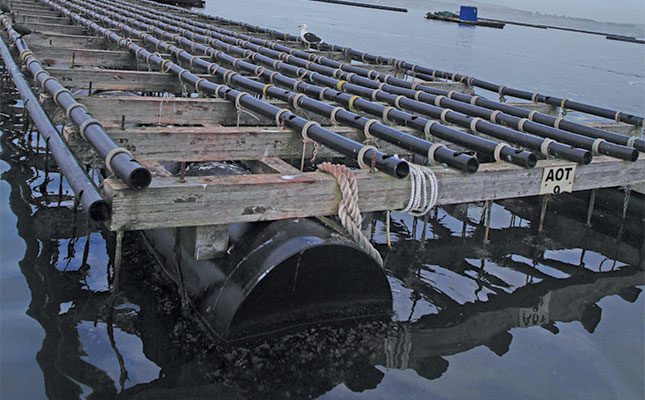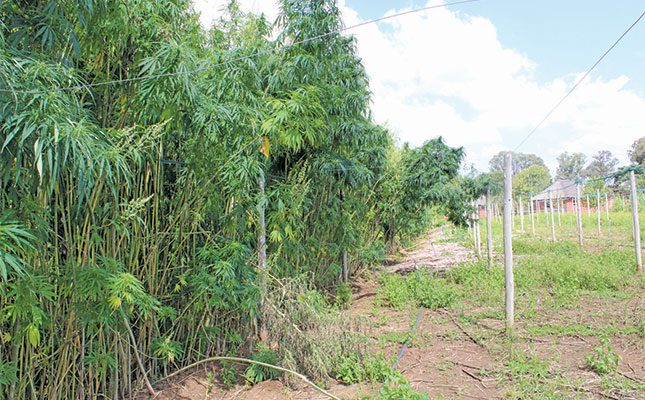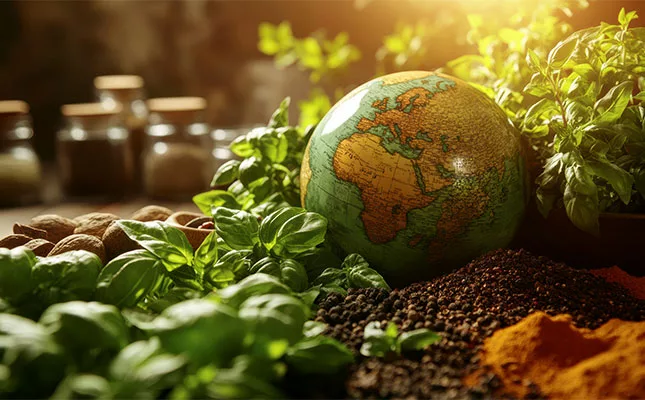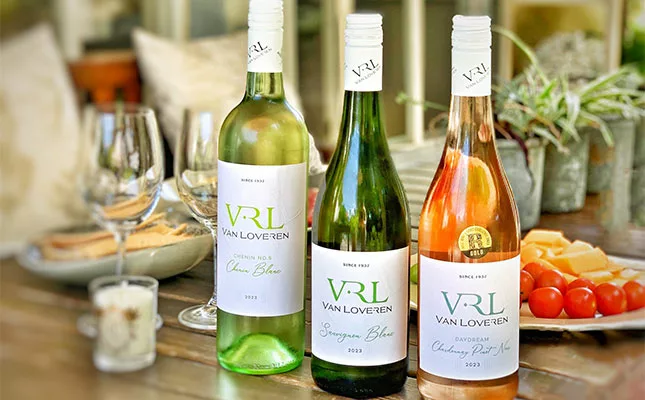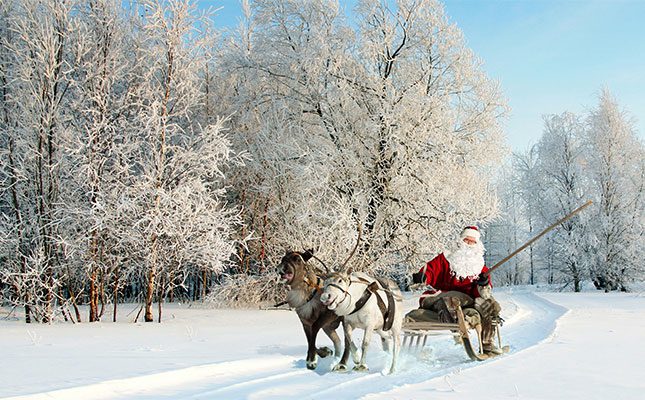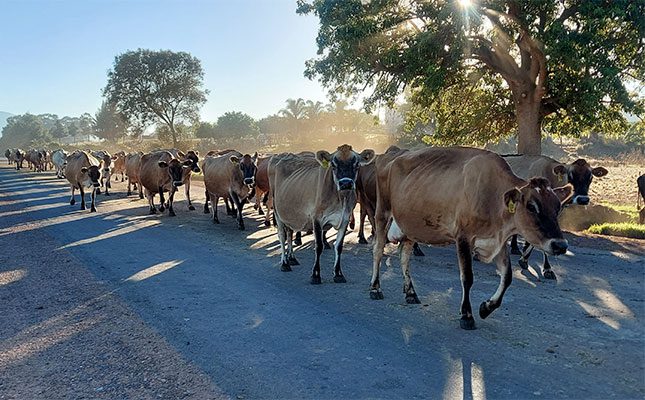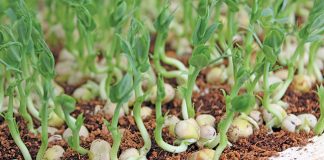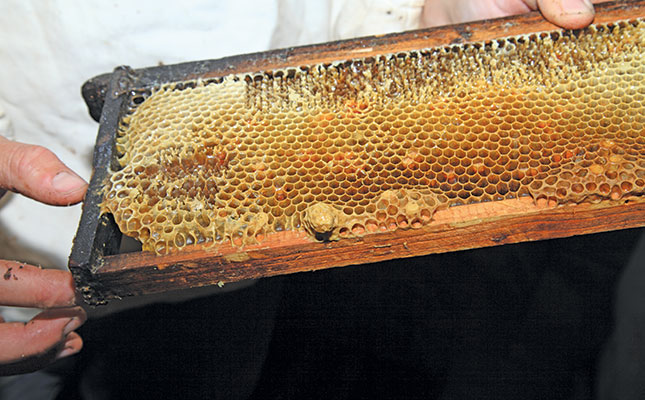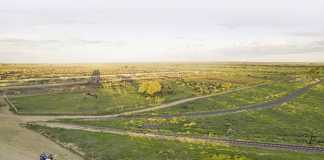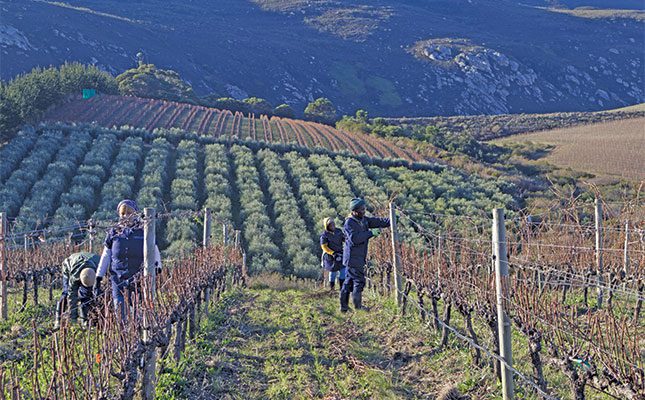
Photo: Supplied
When Carolyn and Jean-Claude ‘JC’ Martin bought a sheep farm near Walker Bay on the Hemel-en-Aarde Ridge in 2002, there was little to indicate they would be able to turn it into what would become one of South Africa’s finest wineries, Creation Wines.
“The Hemel-en-Aarde Ridge was new to winemaking at the time, leaving us with little information to benchmark the farm’s potential. All we had to go on was that the neighbouring farmer produced apples for export, and climates that favour apple colouration are good for wine production,” says JC.
It also helped that both are from wine pioneering families. Swiss-born JC’s grandfather, Jules Martin, established a family winery on the banks of Lake Bienne in Switzerland in 1935, while Carolyn’s grandfather, Maurice Finlayson, bought Hartenberg in Stellenbosch in 1947.
Her father, Walter Finlayson, was the winemaker at Hartenberg from 1965 and Blaauwklippen Wine Estate from 1975.
Walter bought Glen Carlou Wine Estate in 1983 and was one of the eight founding members of the Cape Winemakers’ Guild in 1982.
The husband-and-wife team were farming at Grillette in Neuchâtel, Switzerland, when Carolyn’s uncle, Peter Finlayson, convinced them to buy the farm in Hemel-en-Aarde.
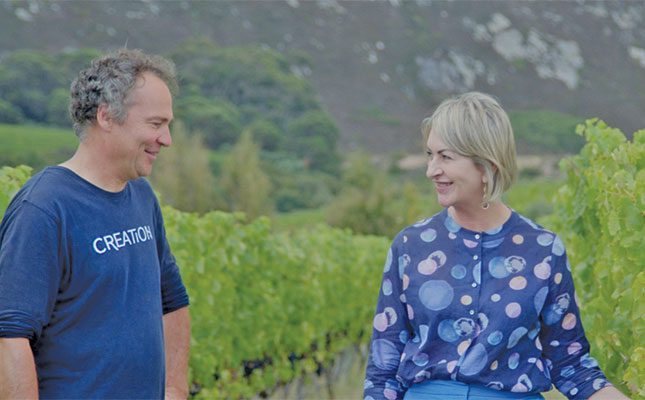
Finlayson had set up the region’s first winery and vineyards at Hamilton Russell in 1979, and started the boutique winery Bouchard Finlayson with Burgundy winemaker Paul Bouchard in 1989.
“Our initial idea was to farm in Switzerland and South Africa, but after planting the first 30ha in South Africa, it became too difficult to juggle two farms,” says JC.
“We decided to focus all our attention on the South African farm because it presented the most potential.
“Also, wine production in Europe had become highly regulated and prescriptive, whereas farmers in South Africa still had the freedom to plant what they wanted.”
A strong foundation
The Martins were attracted to the Hemel-en-Aarde farm because of its cool climatic conditions, abundance of water, and the fact that the farm had never been used for wine production.
JC explains that cool-climate wine regions like theirs, where temperatures rarely exceed 30°C and the night index is about 12° lower than midday temperatures, produce wines with more acidity and lower alcohol than warmer regions do.
The wine, in general, is also more elegant and refined, making it ideal for food pairing.
But the biggest benefit for him is that they don’t have to deal with temperature extremes, which sometimes force farmers to pick grapes according to sugar levels instead of optimal ripeness.
The farm receives about 750mm of rain annually and has a dam to capture the rainwater, as well as an abundance of underground water.

They also have irrigation systems, but these are only used as backup, thanks to the water-retention ability of their heavy clay loam soils with decomposed Bokkeveld shale.
The ability to plant on soil that had never before been planted to vines meant the Martins could start production with a clean slate, with healthy, living soils that had not been pumped full of synthetic fertilisers and pesticides.
More importantly, it means that the soil is free from grapevine leafroll disease, which negatively affects yields and wine quality.
“In the EU and even Australia, many vineyards are 50 years and older. Here, leafroll disease is forcing farmers to replace most vineyards after 15 to 20 years. This is terribly expensive and one of the reasons why many of the wine farms don’t stay in a family for more than three generations,” JC says.
Today, Creation Wines owns the first leafroll disease-free mother block planted post-apartheid.
Carolyn says KWV Plant Improvement, now known as Vititec, started supplying the wine industry with certified disease-free plant material in the early 2000s and was looking for virgin soil to grow more plant material.
They entered into an agreement with Vititec whereby they would monitor the farm for grapevine leafroll disease if the couple bought plant material only from them and supplied the company with cuttings harvested during vineyard pruning for the propagation of plant material for the rest of the wine industry.
“Vititec visits the farm about five times a year and is excellent at identifying infected plants,” says JC. “We usually only have a couple of leafroll incidents per year over the whole 70ha area under production. These vines are marked and removed as soon as possible to prevent the disease from spreading to other vineyards.”
Creation Wines would have been able to qualify as an organic farm under European standards if it was not for their need to use synthetic pesticides to control mealybugs, the main vector of grapevine leafroll disease.
“You simply cannot take chances with mealybugs if you want to preserve a vineyard for future generations. In summer, we use biological control methods, such as parasitic wasps and ladybugs, but they are not 100% effective. Therefore, it may be necessary to use contact pesticides post-harvest only on a specific patch in an infected vineyard.”
Plant material
Since they didn’t know what would work best on the farm, the Martins started out by planting a large variety of cultivars, such as Chardonnay, Pinot Noir, Syrah, Viognier, Grenache, Cabernet Sauvignon, and Merlot.
They bought a neighbouring farm 10 years ago, where they were able to be more strategic in their cultivar choices, and have recently started replacing cultivars they were not satisfied with on the first farm.
“Climatically, nearly everything ripens here, so you are not boxed in for choices. We, however, decided to take out some of our Merlot and replace it with Chardonnay and Pinot Noir, simply because our Chardonnay and Pinot Noir quality gets us more excited,” says JC.
They primarily use a combination of Dijon Burgundy and Rhône clones in vineyard plantings to bring complexity to their wines.
Much variation occurs between clones over time, so JC plans to identify the best-performing vines in each vineyard and then make plant material from these for future plantings – a process called Massal selection.
Creation Wines boasts the largest Chardonnay clone garden in the country as part of Wine South Africa’s Gen-Z project, aimed at comparing the performance of 14 different clones under different conditions over time and, by doing so, improving the overall resilience of the wine industry.
To improve their climate resilience, JC has started changing the row direction of new vineyards, where possible, from south-north to an east-west orientation, and is removing less foliage during leaf works in existing vineyards to keep bunches cool and protect them against sunburn.
He has also started planting Chardonnay and Pinot Noir in double rows, which allows vines in one row to overshadow those in the other row.
This biggest advantage of this, however, is that the higher-density planting allows JC to have just over 6 500 vines per hectare, which increases competition between the vines and helps to suppress production.
“We don’t want to overload the vines. The aim is to produce about 10 bunches of grapes, or 1kg of grapes, per plant,” he says.
Innovative new system
They have also switched from a cordon to a Guyot vine-training system, which people previously thought would not work in South Africa because of our warm temperatures.
Participation in Stellenbosch University’s ClimaVin and Vititec’s Gen-Z projects, however, has revealed that the farm has sufficient cold units to use the Guyot system with a Winkler Type II index.
The canes in this system are longer and have more buds than those in the cordon system, as there is no pre-pruning. Having more fruitful nodes means more growth goes into berry production, compared with vegetative production in the case of the cordon system.
“Choosing the right pruning method is essential at Creation Wines because of our low soil fertility,” says JC.
If done properly, the Guyot system is said to be better for vine longevity, reduce Eutypa dieback, and significantly reduce vineyard management during the suckering phase. The fruiting zone is also less dense, resulting in fewer fungal problems.
JC says they work with nature as far as possible, as evidenced by the fact that the farm is one of the World Wide Fund for Nature South Africa’s Conservation Champions.
They have allocated more than 15ha of their land to conservation. Alien clearing is done in nature zones and the wood is used as firewood in the tasting room.
Organic material from the cellar is composted and used as a mulch inside the vine rows, and a variety of winter cover crops are planted between the rows to protect against erosion, improve soil health and structure, suppress weeds, and create a favourable habitat for pollinators and other beneficial organisms.
“Planting cover crops is easier said than done. Poor soil fertility forces us to give the cover crops organic fertiliser. This year was particularly difficult because the rain came late in April, and then we had to contend with guinea fowls that ate a lot of the seed before it got a chance to germinate,” he adds.
Wine quality
In just a few decades, Hemel-en-Aarde has established itself as a top-quality Pinot Noir and Chardonnay region.
“It is great to see that the region, which probably only has about 110ha under Pinot Noir, is regarded as one of the top 10 producers of this variety outside Burgundy,” says JC.
He attributes the region’s success to the fantastic quality of the wine grapes produced here: “For me, a good wine starts with the production of good-quality wine grapes. The climatic conditions here are so great that you just need to get the basics right in the vineyard and then gently guide the wine during the winemaking process to preserve the sense of place. There is no need for huge interventions.”
He therefore spends more time in the vineyards than in the cellar: “In Switzerland, you must first work in the vineyards before you can make wine. In South Africa, this is not a prerequisite, which I think causes a disconnect between the vineyard’s potential and the winemaker’s winemaking goals.”
To facilitate a connection between the vineyard and the cellar, JC, his viticulturist, Gerhard Bruwer, and his winemaker, Gerhard Smith, eat most of their meals together, especially during harvest time, to discuss what is happening with the wine and in the cellar and address any challenges.
“Our viticultural approach to each vineyard is diverse, based on terroir and cultivar. Each vineyard is treated individually, with tailor-made decisions,” JC says.
Wine tourism: a major lifeline for small wineries
While wine consumption is stagnating internationally, wine tourism is growing and turning into a valuable way for wineries to increase revenue.
JC Martin points out that having a restaurant allows Creation Wines to generate about 35% of their income from direct cellar-door sales, which is more profitable than having to sell through retailers or other middlemen.
Most of the people who visit the farm also become repeat consumers.
Martin believes that South African wineries can do much more to unlock the benefits of wine tourism than wineries in most other countries, thanks to the country’s rich diversity and unique landscapes.
According to the latest research conducted by FTI Consulting on behalf of South African Wine Industry Statistics, wine tourism as a percentage of total turnover of wine cellars rose from 14,7% in 2019 to 17,3% in 2022.
Micro wineries, defined as cellars with a turnover of less than R10 million, were found to generate 36% of their total income from wine tourism, while small cellars, with a turnover of R10 million to R50 million, generated 35% of theirs from wine tourism.
Together, small and micro wine cellars represent 87% of South African wine cellars.
Medium-sized wineries, with turnovers of R50 million to R170 million, represent 8% of South African cellars and were found to generate 19% of their turnover from wine tourism.
Large wineries, with incomes of R170 million to R300 million, represent 3% of South African cellars and generated 22% of their turnover from wine tourism.
Mega wineries, with income of more than R300 million, represent 3% of South African wine cellars and generated 4% of their income from wine tourism.
Wine tourism is also a valuable contributor to job creation and the South African economy. The number of permanent employees increased from 5 809 in 2019 to 6 304 in 2022, while the number of casual employees during peak and off-season increased from 4 414 to 4 798 and from 2 655 to 2 870, respectively.
The number of direct, indirect and induced jobs created is estimated at about 40 108.
Wine tourism’s direct contribution to the economy increased from R2,4 billion in 2019 to R3 billion in 2022, with its direct, indirect and induced impact increasing from R7,2 billion to R9,3 billion over this time.
A sensory experience
What makes Creation Wines different from many other fine wine producers across the world is the connection the Martins are creating with their customers through their on-farm and online tastings.
Carolyn, a food-and-wine-pairing expert, turns wine tasting into an art that engages all the senses but is healthy at the same time.
“Our aim is to create a culture of wine in South Africa: for people to once again sit down and enjoy good food and wine together, instead of rushing a quick meal off in front of the television.
According to feedback from some guests, the experience in our restaurants has resulted in life-changing plans,” she says.
The team consults a dietician and integrative medicine doctor to help with creating meals that have anti-inflammatory properties and are diabetic-friendly, as Carolyn says the health and well-being of their guests are at the heart of the Creation Wines experience.
The Martins’ sentiment is mirrored in the community. For instance, their staff receive a healthy breakfast, lunch, and afternoon tea at work, while they have also hosted numerous workshops to teach their workers to “eat, move, and live better”.
They have also developed a programme in co-operation with an occupational therapist to raise awareness of the importance of children being active.
Along with this, the Martins have worked with Prof Gabriel Lepousez, a neuroscientist from the Sorbonne University in Paris, France, to develop ways to heighten the sensory experience for consumers of their meals.
This starts subtly, for instance with the serving of a parsley and parsnip wafer with watercress soup, making one almost think of communion in church and, in doing so, the role that wine has for centuries played in our lives in religion and celebrations.
Then to ground you back to the farm, the soup bowl may be placed on top of a green plate in the form of a Pinot Noir leaf that was made at The Potter’s Gallery in nearby Kleinmond.
Guests are invited to put a giant periwinkle shell from Hermanus to their ear when tasting the Sémillon Sauvignon Blanc blend, not only to connect them with the terroir and the cool ocean breezes that have turned Walker Bay into a great wine region, but also to awaken the senses and enhance the minerality and salty aroma of the wine.
The feel of silk and velvet scarves is contrasted to enhance one’s awareness of the delicate, silky texture of their Viognier and Pinot Noir.
Along with this, Carolyn has created aroma scent kits to make it easier for people to identify what they are smelling and tasting in the wine. These include ginger, sweet violet, oak, red berries, and even vetiver.
What is also special is that about 80% of the raw materials used in their seasonal menus are sourced from producers within about 80km of the farm.
Carolyn points out that the Overstrand Hermanus Municipality was in 2016 awarded the UNESCO Creative City status for gastronomy, the first and only region in South Africa to receive the accolade.
Neighbouring towns and villages, such as Hawston, Pringle Bay, Rooi-Els, Stanford, Gansbaai, Betty’s Bay and Kleinmond are all partners of this gastronomic hub.
“There is little industrialisation here, we have pure air and water, and climatic conditions foster the production of apples, berries, wine, beer, wheat, sheep, olive oil, artisanal cheese, charcuterie, abalone, fish, flowers, teas and medicines. The best barley and sweet potatoes in the country, for instance, are produced in our region,” she says.
Another huge contributor to their success is their highly skilled and devoted workers. The farm employs 88 people full-time.
“Farm work is often regarded as inexpensive, but at Creation we invest a lot into training to try and turn jobs into careers. We want our workers to be great in what they do so that we can remain competitive internationally,” says Carolyn.
The Martins have achieved much success since they began developing the farm, yet they are most excited about its future potential.
“It is wonderful to taste the success of our endeavours, but we have not yet scratched the peak of what is possible. We hope that we have built a solid foundation for future generations to reach even higher,” says JC.
Email [email protected], or visit creationwines.com.



